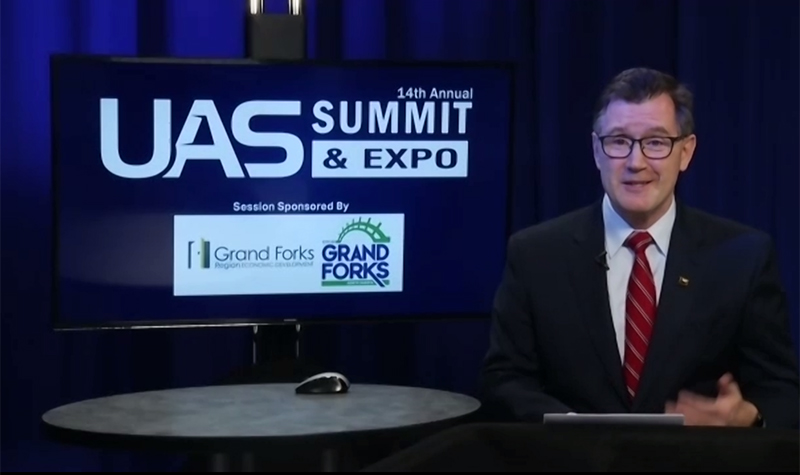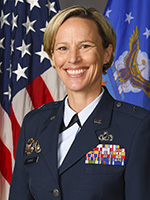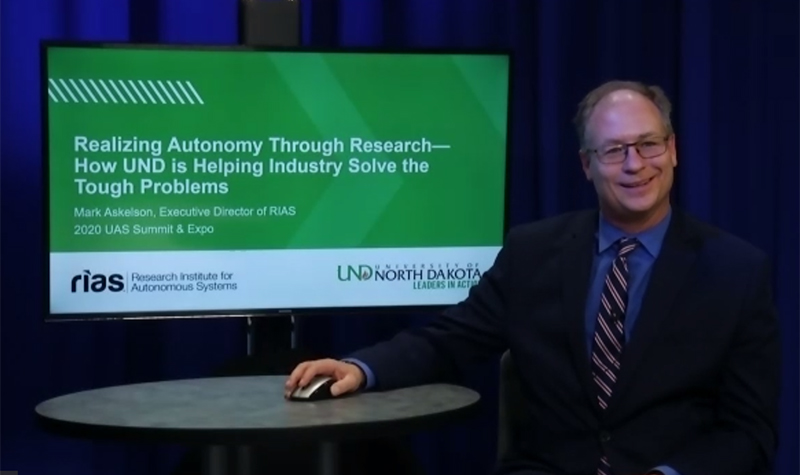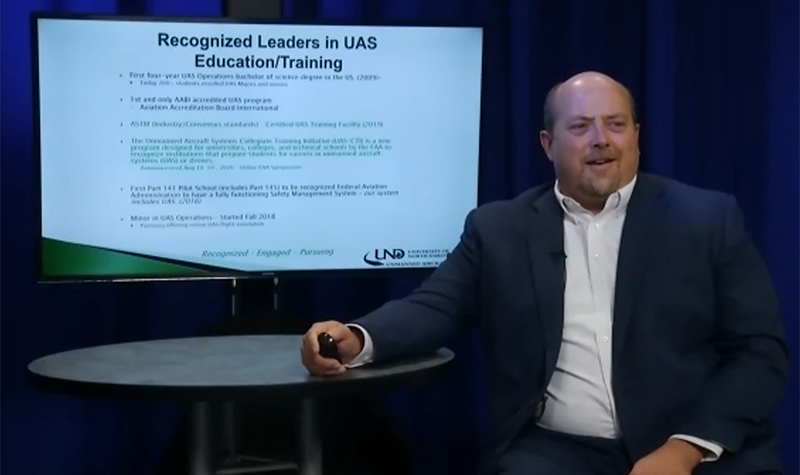“Come fly with the Hawks”
UND’s role in annual UAS Summit & Expo starts with president’s welcome, includes researchers’ updates

Appearing as one of the first speakers at last week’s 14th Annual UAS Summit & Expo, President Andy Armacost introduced himself by making an invitation to the broader unmanned aerial systems industry.
The University of North Dakota’s research programs and educational programs walk hand-in-hand, he said. And both are key to developing a viable workforce in the UAS and autonomous industries, as well as in the defense sector.
“Know that the faculty, staff and students at UND – and I – embrace challenges and intend to continue to lead alongside our partners both in government and in industry,” Armacost said. “We’ll continue to push UND and North Dakota forward through research-and-development and innovation.
“Let me encourage you: Come to North Dakota and fly with the Hawks.”
For the first time in the conference’s history, such an invitation needed to be delivered remotely. Organized by UAS Magazine and BBI International, the UAS Summit & Expo has long represented the convergence of government, academia and businesses comprising the UAS industry through a two-day event of panels, presentations and show-floor engagements. All of the events for 2020 were held virtually.
Kicking off a number of UND mentions and faculty appearances throughout the summit’s first day, Oct. 28, Armacost delivered a high-level overview of the challenges UND has addressed in UAS and autonomous systems, as well as in matters of space exploration.
He briefly chronicled UND’s years of research enabling beyond-visual-line-of-sight (BVLOS) flight operations in the state – work that will enable further integration of UAS into the national airspace system.
The University’s pursuit of such research has developed invaluable expertise alongside corporate sponsorships, commercialization, intellectual property and, most recently, technologies integrated into North Dakota’s statewide BVLOS infrastructure, the president said.
That statewide network was formally introduced as Vantis by Nick Flom, executive director of the Northern Plains UAS Test Site, later in the Summit’s events. Vantis’ installation is scheduled to start soon in the western reaches of the state.
“Nearly two decades in the making, it’s a remarkable story,” remarked Armacost of UND’s efforts.
He also spoke to the ability of UND’s Research Institute for Autonomous Systems (RIAS) to influence policy, safety and public perception around UAS, in addition to technology.
Then the president turned his gaze to the stars.
Armacost reiterated his desire to see Grand Forks boost its role in the space-satellite business, saying the city could become a center for satellites’ design, building and control. This would enhance student engagement and the University’s research portfolio, he noted.
The fact that a number of space leaders have visited UND in recent months has only amplified Armacost’s desire to expand space research and education on campus.
UND is also actively hoping to be designated as University Affiliated Research Center under U.S. Space Command and the U.S. Space Force.
“We have demonstrated the capacity in North Dakota to test and enable UAS both for commercial and defense purposes,” Armacost said. “And, with our partners, we strive to become the environment for testing and developing applications on the ground, in the air and in space.

Friends old and new
Though his speech may have been his first to the conference, there were no shortage of familiar faces for the retired Air Force brigadier general turned university president.

Just before Armacost’s remarks, Space Development Agency Director Derek Tournear joined U.S. Sen. Kevin Cramer, R-N.D., to talk about Tournear’s recent visit to UND, and his agency’s desire to collaborate with UAS innovators. And following Armacost, Brig. Gen. Heather Pringle, Commander of the U.S. Air Force Research Laboratory, appeared on a panel with U.S. Sen. John Hoeven, R-N.D., and Federal Aviation Administration Administrator Steven Dickson. Pringle spoke to how the massive research entity she leads is increasingly looking to industry and academia as partners to leverage ideas for national defense.
She mentioned that she and Armacost have a longstanding friendship as previous instructors at the U.S. Air Force Academy, where Armacost most recently served as dean of the faculty.
“I didn’t know whether to refer to him as ‘president,’ ‘doctor,’ or ‘general’ because of our history back at the Academy,” said Pringle of Armacost. “There is a lot of great leadership in that state with President Armacost on the academic side, and with my brother at Grand Forks Air Force Base.”
Col. Cameron Pringle currently leads the Global Hawks mission of the 319th Reconnaissance Wing stationed in Grand Forks.

Enhancing research through strategic growth, partnerships
Representing UND in later appearances were Mark Askelson, executive director of the Research Institute for Autonomous Systems and a professor and associate dean for research in the John D. Odegard School of Aerospace Sciences, and Professor Paul Snyder, director of UND’s UAS program.
Both faculty members have been mainstays of the annual Grand Forks conference.
Askelson expanded upon Armacost’s description of UND’s research enterprise, particularly in relation to the Grand Challenges initiative for autonomous research and RIAS. He also joined a Wednesday afternoon panel to discuss the progress of testing UAS in North Dakota.
“We have some strategic growth areas that we’ve identified and are working on, including national security and working with industry,” said Askelson at the top of his presentation.
Enhancing partnerships across the existing UAS ecosystem and beyond has been a continuing theme, he explained, as has leveraging the strengths of humans and machines in combination, and developing autonomy that can readily go from the lab to the field.
Askelson buzzed through examples of projects happening in support of the U.S. Department of Defense, state government and the FAA by way of the ASSURE Center of Excellence program – the FAA’s university-based UAS research cohort.
On the later panel, the RIAS executive director sat between Chris Theisen, director of research at the Northern Plains UAS Test Site, and Matt Dunlevy, founder and CEO of SkySkopes, to answer questions regarding FAA waivers and testing progress for UAS, as well as how COVID-19 has affected the outlook on research.
The pandemic has created a number of opportunities for UAS in society, despite certain project delays and necessary adaptations to prevent further spread, the panelists agreed. Askelson said COVID-19 has created challenges, but it’s not stopping UND’s pursuit of autonomy research and UAS integration.
“You have to find a way to work through those barriers and still accomplish your mission,” Askelson said. “These are critical problems that we have to solve to enable the entire industry.”

Recognized leaders
During the “Future of Drone Education” panel, Professor Paul Snyder spoke to the goals of UND’s UAS degree programs, including means by which the nation’s first such program is maintaining its leadership in the space.
“We want to be recognized as leaders in UAS education while being engaged with industry and pursuing state-of-the-art hardware and software for our students,” Snyder said. “When you’re talking about UAS and education, it’s not ‘evolutionary,’ it’s more ‘revolutionary.’
“There are so many things that are going to be happening in the next 10 years that we have to be engaged. We have to be pursuing industry and national involvement so that we can stay on the front edge.”
Examples provided by Snyder included UND being the first institution of its kind to have its training approved by ASTM International, as well as being part of the first round of schools selected for FAA’s UAS Collegiate Training Initiative. Through the initiative, UND will be working with the FAA to improve the curriculum needed to prepare students for the UAS workforce.
The pandemic situation has, perhaps obviously, affected education as much as it has research. Snyder said UND has been working with Simlat, a UAS simulation developer, to move its high-end training software into a remote education setting. The software is used in the program’s biggest course, Intro to UAS, which is a course now required for all commercial aviation students.
“All of these future commercial pilots, they’re going to have to understand how UAS is going to impact them in the national airspace over the next 10 years,” Snyder said. “So this simulation ability has been fantastic because we can get students thinking about where aviation is headed. And now they can get individualized, online training from wherever they are.”
Snyder listed a number of topics covered throughout UND’s programming, such as UAS standards, operations around airports, flying BVLOS, cybersecurity, counter-UAS and unmanned transport operations.
“The sky is the limit as far as opportunities for education in these areas,” Snyder said. “There are lots of exciting things happening at UND.”



